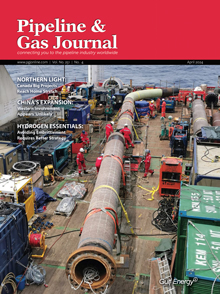Author Guidelines
These guidelines are for authors, or their representatives, wanting to publish a technical article or column in any monthly issue of “Pipeline & Gas Journal” (PGJ). If the author does not yet have an abstract, then the process begins with them sending an email to the PGJ editorial team, with their proposed Title including in what section of the magazine they wish this article to be featured. See PGJ annual Media Planner for dates of Special Focus, regular and bonus features.
- Articles should be focused on the needs and challenges of the operating company (normally a pipeline/utility) and the specific solutions that were designed to handle the situation. Therefore, it’s preferable for articles to be written in a case study/history
format, generally beginning with the conclusion, then developed in a manner that illustrates how the solution was arrived at. If possible, we prefer to see the name of an operating company official involved in the authorship. - Try to limit articles to a range within 1,200 to 2,000 words. Also keep in mind that we often look for one-page articles to publish, which can include about 750 words and an illustration. Send us a brief synopsis of the proposed article so that we have an idea of your topic. We’ll get back to you as quickly as possible with a plan. Articles based on technical papers are acceptable providing that they can be adapted to our standards and have not been published by a competing publication.
- We need to have materials in our hands about six weeks prior to actual publication. This means that for our September issue, we need materials by July 20 and NO LATER than Aug. 1.
- Materials should be submitted in a Word document with any accompanying figures, pictures, etc., sent separately as jpg or tif files. We need high-resolution art, at least 300 dpi. If you have a picture that you would like considered for our cover, it’s recommended that a professional photographer take the picture in order to ensure the highest quality possible. Image size for covers should be at least 2400 px by 2600 px.
- All articles must in some way relate to the pipeline business: natural gas, crude oil or products. This can take the form of articles focusing on construction projects; pipeline integrity (corrosion control, pigging, repair, rehab, remediation work); metering and measurement; LNG; coatings; compression; SCADA/Automation; storage (including tanks); management issues; marketing; plastic/steel pipe; odorization; safety and security; etc. Because of the international nature of our business and readership, we are interested in pipeline work anywhere in the world. For more information or to offer suggestions, look at our Editorial Calendar or call or email the editorial staff.
- Articles should be moderately technical in nature. They should be able to appeal to a manager or engineer of a utility/pipeline company. For instance, we prefer that equations be left out or kept to a minimum. Charts/figures should be limited to 3 or 4.
- Articles MUST remain commercial-free. Any submission that appears as a blatant advertisement for a particular product or service will be rejected. References to a specific product or service are permissible if mentioned only once or twice. The magazine does contain a popular Tech Notes section in which an article is permitted to provide a larger look at a new product or service that seems likely to have an impact on our industry.
- Once submitted to the magazine, all materials become the property of Pipeline & Gas Journal. If an article needs to be strongly edited, we prefer that it be sent back to the author for additional work. This happens occasionally and should not be taken as a rejection. We typically do NOT send articles back for review prior to publication unless a) substantial changes were made; b) requested by the author. Remember that our editors are trained to make your story better, not to rewrite it.
- Try to include a brief biography of the author(s) and a good quality color headshot.
- After the article is published, we will be delighted to send you several complimentary copies at your request. Keep in mind that we are also in the business of publishing reprints, which, for a nominal fee, provide you with an outstanding sales tool. We will post articles on our web site, however, these are not meant for reproduction purposes.
We look forward to working with you.
Sign up to Receive Our Newsletter

- Keystone Oil Pipeline Resumes Operations After Temporary Shutdown
- Freeport LNG Plant Runs Near Zero Consumption for Fifth Day
- Biden Administration Buys Oil for Emergency Reserve Above Target Price
- Mexico Seizes Air Liquide's Hydrogen Plant at Pemex Refinery
- Enbridge to Invest $500 Million in Pipeline Assets, Including Expansion of 850-Mile Gray Oak Pipeline
Pipeline Project Spotlight
Owner:
East African Crude Oil Pipeline Company
Project:
East African Crude Oil Pipeline (EACOP)
Type:
TotalEnergies in discussions with a Chinese company after Russian supplier Chelpipe was hit by sanctions.
Length:
902 miles (1,443 km)
Capacity:
200,000 b/d
Start:
2022
Completion:
2025



